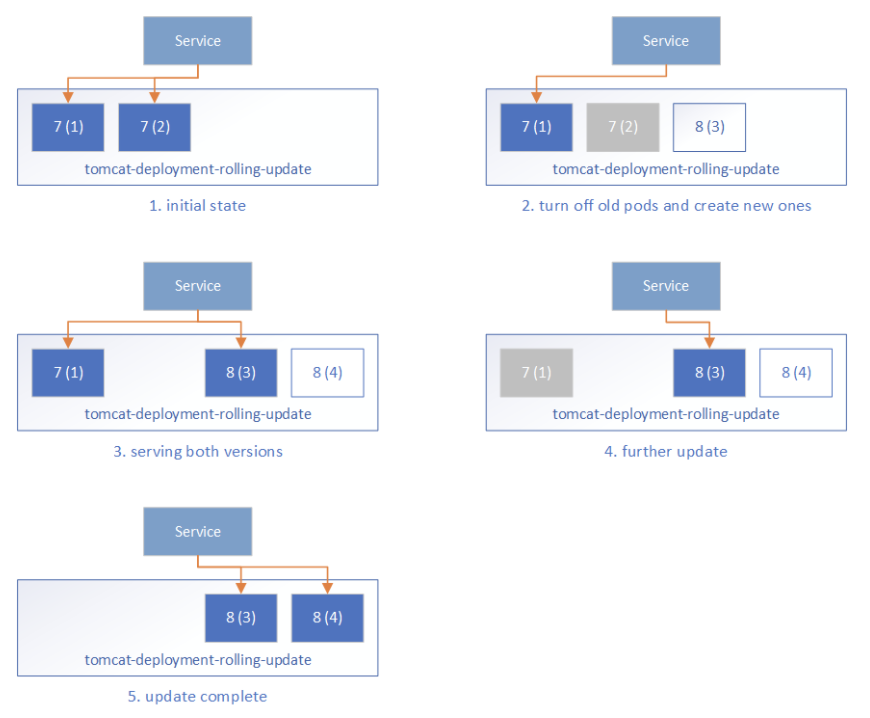Black lives matter.
We stand in solidarity with the Black community.
Racism is unacceptable.
It conflicts with the core values of the Kubernetes project and our community does not tolerate it.
We stand in solidarity with the Black community.
Racism is unacceptable.
It conflicts with the core values of the Kubernetes project and our community does not tolerate it.
Ever since we added the Kubernetes Continuous Deploy and Azure Container Service plugins to the Jenkins update center, "How do I create zero-downtime deployments" is one of our most frequently-asked questions. We created a quickstart template on Azure to demonstrate what zero-downtime deployments can look like. Although our example uses Azure, the concept easily applies to all Kubernetes installations.
Kubernetes supports the RollingUpdate strategy to replace old pods with new ones gradually, while continuing to serve clients without incurring downtime. To perform a RollingUpdate deployment:
.spec.strategy.type to RollingUpdate (the default value)..spec.strategy.rollingUpdate.maxUnavailable and .spec.strategy.rollingUpdate.maxSurge to some reasonable value.
maxUnavailable: the maximum number of pods that can be unavailable during the update process. This can be an absolute number or percentage of the replicas count; the default is 25%.maxSurge: the maximum number of pods that can be created over the desired number of pods. Again this can be an absolute number or a percentage of the replicas count; the default is 25%.readinessProbe for your service container to help Kubernetes determine the state of the pods. Kubernetes will only route the client traffic to the pods with a healthy liveness probe.We'll use deployment of the official Tomcat image to demonstrate this:
apiVersion: extensions/v1beta1
kind: Deployment
metadata:
name: tomcat-deployment-rolling-update
spec:
replicas: 2
template:
metadata:
labels:
app: tomcat
role: rolling-update
spec:
containers:
- name: tomcat-container
image: tomcat:${TOMCAT_VERSION}
ports:
- containerPort: 8080
readinessProbe:
httpGet:
path: /
port: 8080
strategy:
type: RollingUpdate
rollingUp maxSurge: 50%
If the Tomcat running in the current deployments is version 7, we can replace ${TOMCAT_VERSION} with 8 and apply this to the Kubernetes cluster. With the Kubernetes Continuous Deploy or the Azure Container Service plugin, the value can be fetched from an environment variable which eases the deployment process.
Behind the scenes, Kubernetes manages the update like so:

maxUnavailable pods in the desired Pods can be unavailable, that is, at least (replicas - maxUnavailable) pods should be serving the client traffic, which is 2-1=1 in our case.The Rolling Update strategy ensures we always have some Ready backend pods serving client requests, so there's no service downtime. However, some extra care is required:
Blue/green deployment quoted from TechTarget
A blue/green deployment is a change management strategy for releasing software code. Blue/green deployments, which may also be referred to as A/B deployments require two identical hardware environments that are configured exactly the same way. While one environment is active and serving end users, the other environment remains idle.
Container technology offers a stand-alone environment to run the desired service, which makes it super easy to create identical environments as required in the blue/green deployment. The loosely coupled Services - ReplicaSets, and the label/selector-based service routing in Kubernetes make it easy to switch between different backend environments. With these techniques, the blue/green deployments in Kubernetes can be done as follows:
TOMCAT_VERSION=7 and TARGET_ROLE set to blue or green respectively.apiVersion: extensions/v1beta1
kind: Deployment
metadata:
name: tomcat-deployment-${TARGET_ROLE}
spec:
replicas: 2
template:
metadata:
labels:
app: tomcat
role: ${TARGET_ROLE}
spec:
containers:
- name: tomcat-container
image: tomcat:${TOMCAT_VERSION}
ports:
- containerPort: 8080
readinessProbe:
httpGet:
path: /
port: 8080
TARGET_ROLE=blue.kind: Service
apiVersion: v1
metadata:
name: tomcat-service
labels:
app: tomcat
role: ${TARGET_ROLE}
env: prod
spec:
type: LoadBalancer
selector:
app: tomcat
role: ${TARGET_ROLE}
ports:
- port: 80
targetPort: 8080
kind: Service
apiVersion: v1
metadata:
name: tomcat-test-${TARGET_ROLE}
labels:
app: tomcat
role: test-${TARGET_ROLE}
spec:
type: LoadBalancer
selector:
app: tomcat
role: ${TARGET_ROLE}
ports:
- port: 80
targetPort: 8080
TARGET_ROLE=green and TOMCAT_VERSION=8 in the deployment config to update the green environment.tomcat-test-green test endpoint to ensure the green environment is ready to serve client traffic.TARGET_ROLE=green.
As compared to Rolling Update, the blue/green up* The public service is either routed to the old applications, or new applications, but never both at the same time.
Jenkins provides easy-to-setup workflow to automate your deployments. With Pipeline support, it is flexible to build the zero-downtime deployment workflow, and visualize the deployment steps. To facilitate the deployment process for Kubernetes resources, we published the Kubernetes Continuous Deploy and the Azure Container Service plugins built based on the kubernetes-client. You can deploy the resource to Azure Kubernetes Service (AKS) or the general Kubernetes clusters without the need of kubectl, and it supports variable substitution in the resource configuration so you can deploy environment-specific resources to the clusters without updating the resource config. We created a Jenkins Pipeline to demonstrate the blue/green deployment to AKS. The flow is like the following:

acsDeploy azureCredentialsId: 'stored-azure-credentials-id',
configFilePaths: "glob/path/to/*/resource-config-*.yml",
containerService: "aks-name | AKS",
resourceGroupName: "resource-group-name",
enableConfigSubstitution: true
For the Rolling Update strategy, simply deploy the deployment configuration to the Kubernetes cluster, which is a simple, single step.
We built a quickstart template on Azure to demonstrate how we can do the zero-downtime deployment to AKS (Kubernetes) with Jenkins. Go to Jenkins Blue-Green Deployment on Kubernetes and click the button Deploy to Azure to get the working demo. This template will provision:
tomcat:7 image.tomcat-test-blue and tomcat-test-green), which are connected to the corresponding deployments, and can be used to test if the deployments are ready for production use.tomcat-service) which represents the public endpoint that the users will access. Initially it is routing to the "blue" environment.stage('Confirm') {
mail (to: 'to@example.com',
subject: "Job '${env.JOB_NAME}' (${env.BUILD_NUMBER}) is waiting for input",
body: "Please go to ${env.BUILD_URL}.")
input 'Ready to go?'
}
Follow the Steps to setup the resources and you can try it out by start the Jenkins build jobs.